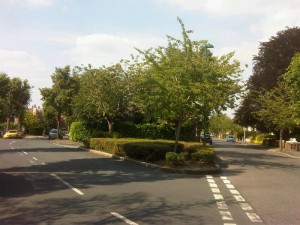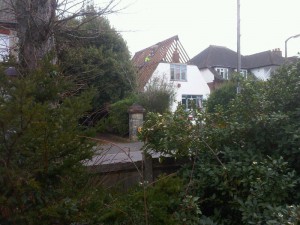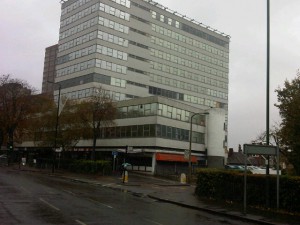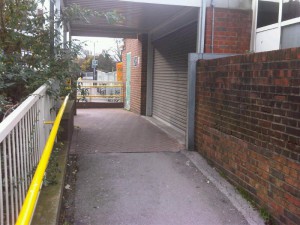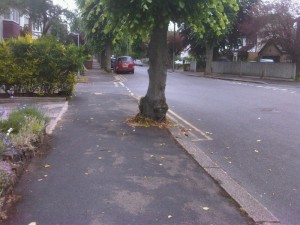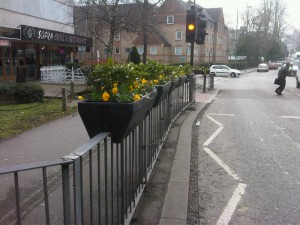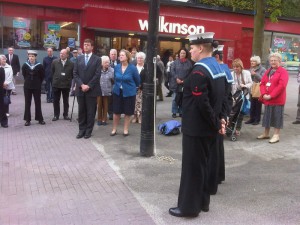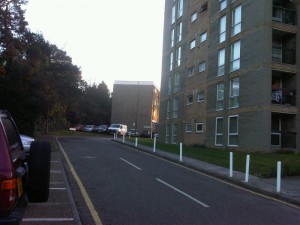39A EATON ROAD: PLANNING LAW MUST BE RESPECTED
The building at 39a Eaton Road has already had two applications rejected by Sutton Council, but the developer had won on appeal. When a second developer finally started building, he decided to amend the design, thus departing from the design for which he had permission. Window bays were wider, the height of the building had increased by half a metre, with roof lights projecting above the ridge of the roof by a further half a metre.
Letters of objection had been received from 62 properties.
Richard said: “Local people were unhappy that the developer had failed to understand the principle that, if you have Planning Approval, that is what you build to, and not something else. Builders know this. Architects know this, so why didn’t the developer?”
Councillor Mary Burstow said: “When I saw the plans for the first time, I was surprised by how the amendments had increased the buildings size and bulk. The building no longer looked like a large house, trying to blend in with its neighbours, it looked like an ugly block of flats.”
Should the applicant appeal to the Planning Inspectorate and be unsuccessful he will have to lower the roof height and reduce the width of the window bays. The cost of doing this will be significant. Richard said “It is very important the developers understand that Sutton Council is not a soft touch when it comes to planning permission.”
RICHARD WARNS OF SHORTAGE OF AFFORDABLE HOUSING
RICHARD SEEKS WIDENING OF GATEWAY PROJECT
125 th. ANNIVERSARY CELEBRATIONS
The weekend of the 13th and 14th July marked the 125th. anniversary of Christchurch in Christchurch Park.
Richard brought the New London Concert Band, for whom he plays trumpet, to Christchurch on Sunday afternoon to perform a concert, as part of the celebrations. A large audience, on a hot day, listened to a concert that included a selection of James Bond themes, some Bach, a lot of Leroy Anderson (Blue Tango, Belle of the Ball), themes from Walt Disney films, and a lot more.
CARING FOR SUTTON’S 20 000 STREET TREES
Sutton is famous for its street trees, over 20 000 in the Borough and over a thousand in our Ward. It is what gives Sutton its green, pleasant, suburban feel that people so like. Low crime, good schools and a pleasant suburban feel. We like Sutton.
A lot of correspondence with residents this summer about the basal growth of trees, which seems to have been particularly vigorous. The programme is well underway to cut it back and we are monitoring progress. We got them to give priority to Cavendish Road and some trees on street corners, like the one below, where the basal growth was affecting sight lines of car drivers at junctions.
And after.
A COMPLETE WARD TOUR
Heather and Richard marked the first day of July by spending the morning undertaking a complete tour of the Ward, going down every road. They noted every pothold in the Ward and were able to compile a full list of problems – including areas where there was a bit of rubbish that needed clearing up, a dumped washing machine and sink, some graffiti (not a lot, this is much less of a problem than it was a few years ago), and candidates for further grit bins (but there are a lot in the Ward already) and rubbish bins. Basal growth of trees is vigorous this year but the programmeto cut it back is underway. We have noted some specific problems and got them dealt with.
Let us know of any locations you are concerned about that ought to be on their list.
HOW IS SUTTON SURVIVING THE RECESSION?
The latest data continue to show that Sutton is surviving the recession well.
They show that average house prices in Sutton (as measured by the average price of houses in Sutton sold in any particular month) were up almost 1% in February of this year compared to the previous month, and stood at 4.2% above the figure for a year previously. The cost of the average house sold in February, the latest month for which reliable data are available, was £255 000. This bullishness in the housing market is generally taken as an indicator of confidence in the local economy.
Positive indicators include:
The economic activity rate of working age adults in Sutton, at 81%, continues to be well above the average for London, which is 76%. Sutton residents continue to find work, and the percentage has increased (by 0.5%) in the last year. Many residents commute to central London for work, and it is unsurprising that the average pay of employees working in Sutton (£519 a week) is less than that in central London.
This finding, that Sutton residents continue to find work, is supported by the decline in numbers claiming Job Seekers Allowance, down by 7% in March compared to the figure for a year previously.
That said, the number of people who have been collecting JSA for over a year has risen in the last year, suggesting that those who have become distanced from the labour market are finding it more difficult to get work. Richard says this mirrors what he finds, as a local Councillor, in his casework, with people made redundant in their 50’s often finding it hard to get back into work.
This suggests that the Council’s “Opportunity Sutton” programme is an important priority. Jobs are gold dust and the prosperity of the Borough depends on people finding and staying in work.
New business start ups were at a record level in Sutton in 2012, with 863 new companies formed.
The number of local companies going into administration was down in the most recent quarter (January to March) and down on figures for a year previously.
The data that comes to the Housing, Economy and Business Committee usually shows a mixed picture, but the latest data are mostly encouraging. One negative that concerns us is that enquiries to Sutton’s Citizens’ Advice Bureau were up by about 5% in the last quarter, with debt advice enquiries increasing by 8.8%. Richard has said his piece, at Sutton Council meetings, about the problem of “payday” loans and we cannot see why it is impossible to have a maximum figure for the interest charged on these loans (it can be over 1000% APR) imposed in law. Richard’s comments are included in a separate post on this site on this subject.
This information is analysed by Richard in his role as vice-chair of the Council’s Housing, Economy and Business Committee, which has oversight of economic development matters and the “Opportunity Sutton” programme. This is currently generating projects involving over £90 million worth of investment in Sutton, including the “Sutton Gateway” project to develop and improve the area from Sutton Court to the station. We hope this will include improving and opening up the side entrance to Sutton station, better shops and restaurants, new jobs from office development, more housing as Sutherland House is developed, the relocation of the recycling bins at The Quadrant and a general tidying up of the area.
RAISING THE FLAG
AVOIDING THE MISERY OF HOMELESSNESS – RICHARD COMMENDS THE COUNCIL’S APPROACH
It fell to Richard, as vice-chair of Sutton’s Housing, Economy and Business Committee, to make the case, when the Committee met on 18 June, for the scrutiny report prepared by the Committee on the Council’s procedures to deal with those about to become homeless.
Richard told the Committee that homelessness – being put in bed and breakfast accommodation often far from Sutton – is a terrible experience, especially for families. It can lead to people losing their jobs if they are too far away to travel back every day. It can lead to mental breakdown, marriage breakdown, and the disruption of the education of children. Our first priority is to avoid this, and it is not too much to ask landlords to wait a week or two in some cases before a property is vacated as a last effort is made to find somewhere else to live.
The report commended the approach that the Council has traditionally used, and was implicitly critical of modifications to the procedure introduced in Feruary to respond to some criticisms of the approach that, the scrutiny report concluded, were not well founded.
This was the first scrutiny study undertaken by one of the Council’s subject committees established when governance arrangements were revised last year. The Committee studied a number of documents when it met on 19 March, and listened to a variety of views, from Council officers, from officers from a neighbouring authority (Croydon) and a landlord who voiced criticisms of the Council’s approach. It was evident from these documents that Sutton’s approach is identical to that of most, indeed almost all, London Boroughs.
The report describes the procedures followed by the Council. To evict a tenant from a property a landlord has to go through a legal procedure with a number of steps commencing with a notice to quit and ending with the execution of a bailiff’s warrant.
Richard, whose daughter works for the largest charity supporting the homeless in the West Midlands, commented:
“This is a procedure involving a private landlord and a private tenant, so it is worthwhile just reminding ourselves why the Council gets involved atall. This is because at the end of the procedure, if someone has no other accommodation and is homeless and in priority need, the obligation falls on the Council to find them accommodation. This usually means putting them in bed and breakfast accommodation, something that can be soul destroying for the family or individual concerned, and an expensive procedure involving costs that ultimately fall on our own Council tax payers.
So, the Council has a unit doing all in its power to assist those threatened with homelessness to find new accommodation. The report shows that in many cases they are successful, and that alternative accommodation is often found quite late in the eviction process. If they are not successful, at the end of the process the tenant will be put into bed and breakfast accommodation, but this is rightly regarded as a last resort to be undertaken when all else has failed. The process followed is described in Appendix A of the paper, and the first recommendation in the paper is to support the approach described, on the basis that this offers the best chance of minimising the numbers made homeless, thus minimising both the cost and human misery that homelessness involves, but correctly discharging the Council’s legal duties to those threatened with homelessness.
The criticisms of the approach, first voiced by Councillor Shields at a Council meeting, picked up by the local paper in the memorable but misleading headline “Council says wait till the bailiffs arrive”, and repeated by at least one landlord, appear to be that by waiting to the end of the process the Council runs the risk of upsetting landlords and thus discouraging landlords from working with the Council. It was also suggested that the tenants are disadvantaged by having a Court judgement against them. But the evidence in the paper (paragraphs 2.18 to 2.30) is that the Council maintains good relations with landlords, and that the Court judgement relates to possession of a property and does not affect the standing of the individual or family made homeless.
Officers told us, however, that for a period from February 2013 a modified approach was trialled, described in Appendix B, involving moving earlier to accept someone was homeless if it appeared that there was no realistic prospect of finding alternative accommodation. It is not often that, in assessing policy options, one can compare the outcome from two periods where different policies were tried. But the evidence in the paper (see paragraphs 2.16 and 3.8) is that the modified approach led to an increase in homelessness, as accommodation is often found for those threatened with homelessness quite late in the process.
So the recommendations support our continuing to follow the procedures described in Appendix A, but also call on officers to continue to work closely with landlords, keep the trends and statistics under review, and report back to us in due course.
Homelessness – being put in bed and breakfast accommodation often far from Sutton – is a terrible experience, especially for families. I know from my casework that it can lead to people losing their jobs if they are too far away to travel back every day, to mental breakdown, to marriage breakdown, and to the disruption of the education of children. Our first priority is to avoid this, and it is not too much to ask landlords to wait a further week or two in some cases before a property is vacated as a last effort is made to find somewhere else to live.”

